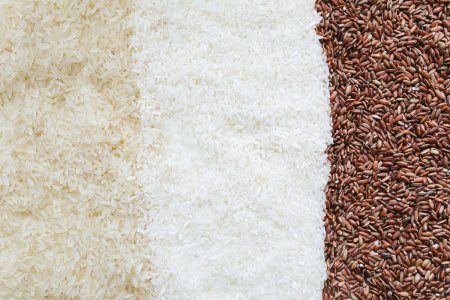Is your rice safe? A new report reveals findings that may surprise you
By
Veronica E.
- Replies 0
Whether it’s the comforting base of a hearty casserole, the fluffy side dish to your Sunday roast, or the foundation of a quick and easy stir-fry, rice has earned its place as a pantry staple in many American homes.
For generations, it’s been a go-to ingredient—simple, versatile, and satisfying.
But now, a new report is raising questions about what else might be in that bowl of rice.
If rice is part of your regular meals—and for many of us, it is—you may want to take a moment to understand what researchers have found hiding in those familiar grains.
The findings are eye-opening, and they could change the way you think about what’s on your plate.

A new study by the nonprofit group Healthy Babies, Bright Futures found that every single rice sample collected from grocery stores across the US contained arsenic—a toxic heavy metal.
The group, which focuses on reducing babies’ exposure to harmful chemicals, tested 105 different rice brands from 20 major metropolitan areas and found several additional metals, including cadmium, lead, and mercury.
Here’s a snapshot of the findings:
Popular brands such as Trader Joe’s, Ben’s, and Goya were among those tested.
You might associate arsenic with mystery novels or old horror stories, but it’s a very real issue.
According to the Environmental Protection Agency, inorganic arsenic—the type found in rice—is classified as a carcinogen.
The FDA notes that long-term exposure can increase the risk of cancer, heart disease, and developmental delays in children.
Other metals found in the report—cadmium, lead, and mercury—are also harmful.
Even at low levels, these toxins can accumulate in the body over time and impact everything from kidney health to the nervous system.
Unlike many crops, rice is often grown in flooded fields, which makes it more prone to absorbing arsenic and other metals from soil and water.
The problem varies by region, and some rice types tend to absorb more than others.
The USA Rice Federation responded in a public statement, saying, “We do not agree that there is a public health safety issue as a result of trace amounts of arsenic in rice,” while also noting that they are working with the FDA to maintain safety standards.
This news doesn’t mean you have to give up rice altogether.
Experts suggest a few simple steps that can help you reduce your exposure:
1. Cook rice in extra water and drain it
Using 6 to 10 cups of water for every cup of rice and draining the excess can significantly lower arsenic levels.
2. Choose rice types with lower heavy metal levels
The report found lower levels of arsenic in:
Meanwhile, brown rice, white rice from the Southeastern US, and arborio rice (used in risotto) were found to have higher levels.
3. Try other grains
Alternatives like quinoa, barley, and couscous usually contain far fewer heavy metals.
4. Rinse rice before cooking
While rinsing won’t remove arsenic completely, it helps clear surface contaminants.
5. Don’t overdo it
Like many things, moderation is key. If rice is just one part of a diverse diet, your overall risk is likely lower.
It’s not just rice.
Other foods like leafy greens, root vegetables, and even some fruit juices can contain small amounts of heavy metals.
The safest strategy is to eat a wide variety of foods and not rely too heavily on any single one.
Surprisingly, while the FDA has set a limit for arsenic in infant rice cereal, there is no federal limit for arsenic in rice sold to the general public.
Advocacy groups are urging stronger oversight to ensure food safety for everyone—not just babies.
Read next: Costco shoppers are racing to find this crispy new snack—here’s why it’s flying off shelves

Have you adjusted the way you cook or shop for rice? Do you have favorite alternatives or tips to share? We’d love to hear from you. At The GrayVine, we believe that sharing knowledge helps us all make smarter, healthier choices.
For generations, it’s been a go-to ingredient—simple, versatile, and satisfying.
But now, a new report is raising questions about what else might be in that bowl of rice.
If rice is part of your regular meals—and for many of us, it is—you may want to take a moment to understand what researchers have found hiding in those familiar grains.
The findings are eye-opening, and they could change the way you think about what’s on your plate.

Rice is a staple in many American kitchens, but new findings are prompting closer attention to what’s in every grain. Image Source: Pexels / Polina Tankilevitch.
What researchers found in your rice
A new study by the nonprofit group Healthy Babies, Bright Futures found that every single rice sample collected from grocery stores across the US contained arsenic—a toxic heavy metal.
The group, which focuses on reducing babies’ exposure to harmful chemicals, tested 105 different rice brands from 20 major metropolitan areas and found several additional metals, including cadmium, lead, and mercury.
Here’s a snapshot of the findings:
- 100% of rice samples contained arsenic
- 1 in 4 samples exceeded the FDA’s limit for arsenic in infant rice cereal (100 parts per billion)
- No federal standard exists for arsenic levels in regular rice
- Total heavy metals (arsenic, cadmium, lead, mercury) averaged between 63 to 188 ppb, with some exceeding 240 ppb
- Arsenic appeared in the highest concentrations, followed by cadmium
Popular brands such as Trader Joe’s, Ben’s, and Goya were among those tested.
Also read: Is your tap water giving you cancer? What 40 million Americans need to know now!
Why arsenic in rice is a concern
You might associate arsenic with mystery novels or old horror stories, but it’s a very real issue.
According to the Environmental Protection Agency, inorganic arsenic—the type found in rice—is classified as a carcinogen.
The FDA notes that long-term exposure can increase the risk of cancer, heart disease, and developmental delays in children.
Other metals found in the report—cadmium, lead, and mercury—are also harmful.
Even at low levels, these toxins can accumulate in the body over time and impact everything from kidney health to the nervous system.
Why is rice especially at risk?
Unlike many crops, rice is often grown in flooded fields, which makes it more prone to absorbing arsenic and other metals from soil and water.
The problem varies by region, and some rice types tend to absorb more than others.
Also read: You won't believe how this simple daily beverage can dramatically improve your health!
What the rice industry says
The USA Rice Federation responded in a public statement, saying, “We do not agree that there is a public health safety issue as a result of trace amounts of arsenic in rice,” while also noting that they are working with the FDA to maintain safety standards.
Safer ways to enjoy rice
This news doesn’t mean you have to give up rice altogether.
Experts suggest a few simple steps that can help you reduce your exposure:
1. Cook rice in extra water and drain it
Using 6 to 10 cups of water for every cup of rice and draining the excess can significantly lower arsenic levels.
2. Choose rice types with lower heavy metal levels
The report found lower levels of arsenic in:
- Calrose, sushi, and white rice grown in California
- Jasmine rice from Thailand
- Basmati rice from India
Meanwhile, brown rice, white rice from the Southeastern US, and arborio rice (used in risotto) were found to have higher levels.
3. Try other grains
Alternatives like quinoa, barley, and couscous usually contain far fewer heavy metals.
4. Rinse rice before cooking
While rinsing won’t remove arsenic completely, it helps clear surface contaminants.
5. Don’t overdo it
Like many things, moderation is key. If rice is just one part of a diverse diet, your overall risk is likely lower.
Also read: Could every bite of these popular cookies expose you to ingredients linked to autism?
What about other foods?
It’s not just rice.
Other foods like leafy greens, root vegetables, and even some fruit juices can contain small amounts of heavy metals.
The safest strategy is to eat a wide variety of foods and not rely too heavily on any single one.
Surprisingly, while the FDA has set a limit for arsenic in infant rice cereal, there is no federal limit for arsenic in rice sold to the general public.
Advocacy groups are urging stronger oversight to ensure food safety for everyone—not just babies.
Read next: Costco shoppers are racing to find this crispy new snack—here’s why it’s flying off shelves
Key Takeaways
- A new report found arsenic in 100% of rice samples tested from US grocery stores, with 1 in 4 samples exceeding the FDA limit for infant rice cereal.
- Other heavy metals—cadmium, lead, and mercury—were also found, with arsenic showing the highest levels.
- Experts recommend cooking rice in extra water, choosing specific types like Calrose or jasmine, and considering alternatives like quinoa or barley.
- No federal limit currently exists for arsenic in regular rice, despite its wide consumption across the country.
Have you adjusted the way you cook or shop for rice? Do you have favorite alternatives or tips to share? We’d love to hear from you. At The GrayVine, we believe that sharing knowledge helps us all make smarter, healthier choices.






